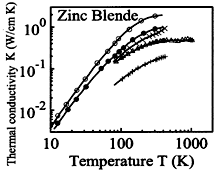
Slack (1973), Makedon et al. (1972)

1- undoped Zinc blende BN;
2-4 - Se doped Zinc blende BN
Selenium concentration:
2 -- 2.4 x 1018 cm-3, before annealing;
3 -- 2.4 x 1018 cm-3, annealed;
4 -- 1019 cm-3, annealed
Shipilo et al. (1986)

| Remarks | Referens | ||
| Bulk modulus | 400 GPa | ||
| Debye temperature | 1700 K | ||
| Melting point, Tm | 2973° C | also see Phase diagrams for BN. | Wentorf (1957) |
| Specific heat | ~0.6 J g-1°C -1 | ||
| Thermal conductivity experimentally achieved theoretically estimated |
7.4 W cm-1 °C -1 ~13 W cm-1 °C -1 |
||
| Thermal expansion, linear |
1.2·10-6 °C -1 |
| Remarks | Referens | ||
| Debye temperature | 400 K | ||
| Bulk modulus | 36.5 GPa | ||
| Melting point | see Phase diagrams for BN. | Solozhenko (1994) and Solozhenko et al.(1998) | |
| Decomposition temperature, Tdec | 2600(100) K | Janaf Thermochemical Tables (1965) | |
| Specific heat | ~0.8 J g-1°C -1 | ||
| Thermal conductivity parallel to the c axis perpendicular to the c axis |
=<0.3 W cm-1 °C -1 =<6 W cm-1 °C -1 |
Rumyantsev et al. (2001) | |
| Thermal expansion, linear parallel to the c axis perpendicular to the c axis |
38·10-6 °C -1 -2.7·10-6 °C -1 |
| Crystal structure | Wurtzite | Zinc Blende | Hexagonal |
| Bulk modulus | 400 GPa | 400 GPa | 36.5 GPa |
| Melting point | |||
| Specific heat | ~0.75 J g-1°C -1 | ~0.6 J g-1°C -1 | ~0.8 J g-1°C -1 |
| Thermal conductivity experimentally achieved theoretically estimated |
7.4 W cm-1 °C -1 ~13 W cm-1 °C -1 |
||
| parallel to the c axis perpendicular to the c axis |
<0.3 W cm-1 °C -1 <6 W cm-1 °C -1 |
||
| Thermal expansion, linear |
1.2·10-6 °C -1 | ||
| Thermal expansion, linear parallel to the c axis perpendicular to the c axis |
2.7·10-6 °C -1 2.3·10-6 °C -1 |
38·10-6 °C -1 -2.7·10-6 °C -1 |
|
 |
BN, Zinc Blende. Temperature dependence of thermal conductivity
for different samples. Slack (1973), Makedon et al. (1972) |
 |
BN, Zinc Blende. Temperature dependences of the thermal conductivity
of undoped and Se doped before and after annealing at 900-1000 K. 1- undoped Zinc blende BN; 2-4 - Se doped Zinc blende BN Selenium concentration: 2 -- 2.4 x 1018 cm-3, before annealing; 3 -- 2.4 x 1018 cm-3, annealed; 4 -- 1019 cm-3, annealed Shipilo et al. (1986) |
 |
BN, Hexagonal. Thermal conductivity perpendicular to the c
axis versus temperature of three samples deposited at different
temperatures. Duclaux et al. (1992) |
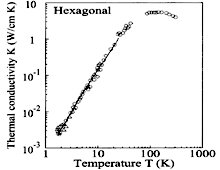 |
BN, Hexagonal. Thermal conductivity perpendicular to the c
axis versus temperature of highly oriented samples. Sichel et al. (1976) |
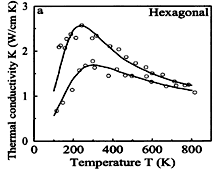 |
BN, Hexagonal. Thermal conductivity perpendicular to the c axis as a function of temperature for two samples. Simpson & Stuckes (1971) |
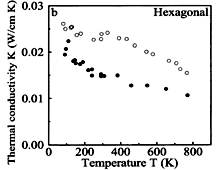 |
BN, Hexagonal. Thermal conductivity parallel to the c axis as a function of temperature for two samples. Simpson & Stuckes (1971) |
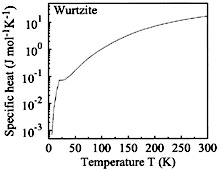 |
BN, Wurtzite. Temperature dependence of the specific heat. Gorbunov et al. (1988); see also Sirota & Kofman (1976) and Inaba & Yoshiasa (1997). The abnormality with extremum at 21 K is caused by the presence of the ordered point defects system in the lattice for two samples. Solozhenko (1994) |
At 420 K < T < 980 K, the specific heat Cp of
Wurtzite BN can be approximated as
Cp= 48.35x (T2 ·(T2-
8.37xT+ 68306)-1)2 (J/Kmol) Solozhenko
(1994).
 |
BN, Zinc Blende. Temperature dependence of the specific heat at low temperatures (single crystal). Solozhenko et al. (1987); see also Sirota & Kofman (1976). |
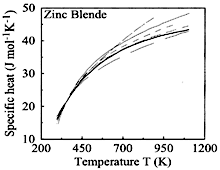 |
BN, Zinc Blende. Temperature dependence of high temperature specific heat according to different authors. Lyusternik and Solozhenko (1992). |
At 300 < T < 1100 K, the specific heat Cp of
Zinc Blende BN can be approximated as
Cp= 48.4x (T2 · (T2-
9.71xT+ 60590)-1)2 (J/Kmol) Lyusternik
and Solozhenko (1992).
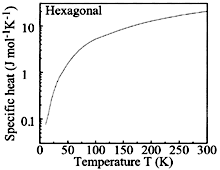 |
BN, Hexagonal. Temperature dependence of specific heat. Gorbunov et al. (1988); see also Sichel et al. (1976) |
At 1300 < T < 2200 K, the specific heat Cp of
can be approximated as
Cp= 52.48 - 9.42·10-4 x T - 64877
x T-2 (J/Kmol) Solozhenko
(1994).
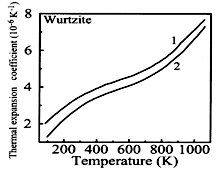 |
BN, Wurtzite. Linear thermal expansion coefficient of parallel (curve
1) and perpendicular (curve 2) to c axis. Kolupayeva et al. (1986). |
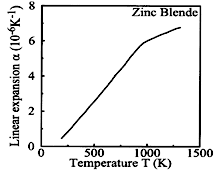 |
BN, Hexagonal. Linear thermal expansion coefficient. Slack & Bartram (1975). |
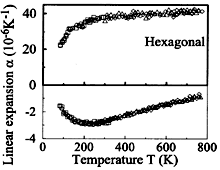 |
BN, Zinc Blende. Linear thermal expansion coefficient Top curve, in a direction parallel to the c axis; bottom curve, in a direction perpendicular to the c axis. Yates et al. (1975). See also Belenkii et al. (1985). |
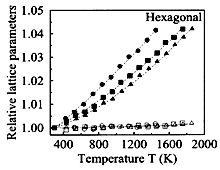 |
BN, Hexagonal. Thermal expansion at different pressure: circles, 1.6 GPa; squares, 5.0 GPa; triangles, 7.1 GPa. Solid and open symbols are used for the directions parallel and perpendicular to c axis, respectively. Solozhenko & Peun (1997). |
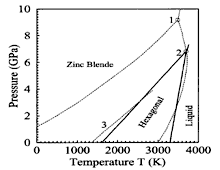 |
Phase diagrams for BN. 1, Bundy-Wentorf's diagram; 2, Equilibrium diagram; , h-BN <=> c-BN boundary line. Solozhenko (1994) |
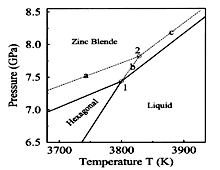 |
Equilibrium phase diagram of BN. 1 is hexagonal-zinc blende BN liquid triple point; 2 is hexagonal-wurtzite BN liquid metastable triple point; a) line of hexagonal-wurtzite BN metastable equilibrium; b) metastable beam of hexagonal BN melting curve; c) line of wurtzite BN metastable melting . Solozhenko et al.(1998) |